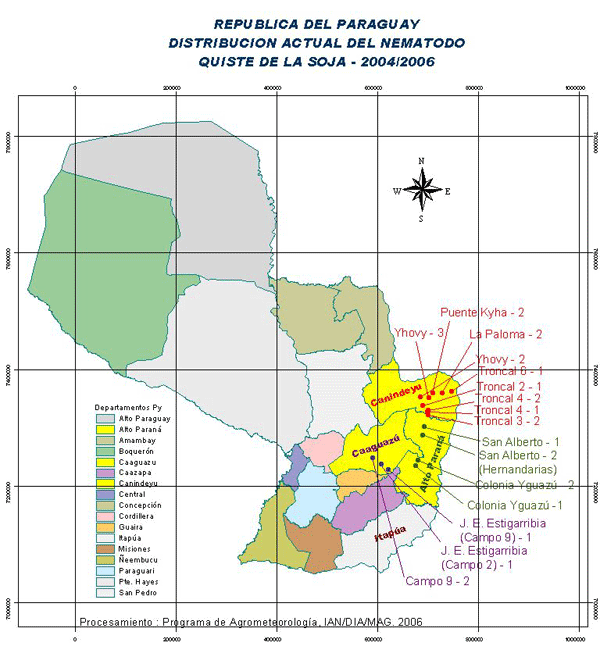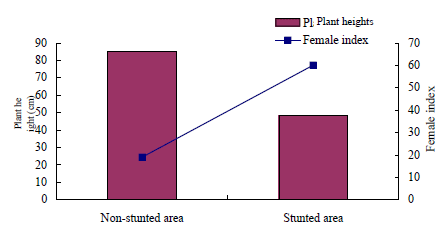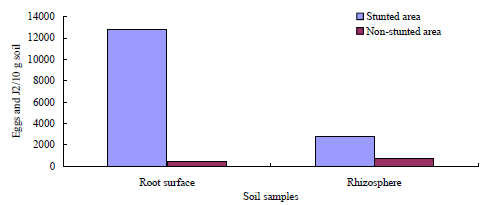First report on the growth reduction of soybean caused by Heterodera glycines and its distribution in Paraguay
Description
The soybean cyst nematode, Heterodera glycines, one of the most widespread and destructive soybean pests, was identified in Paraguay in 2002. Since soybean is the most important crop in the country, the distribution of this nematode was surveyed. Soil samples were collected from 64 fields in the main soybean producing districts of Alto Parana, Itapua, Canindeyu and Caaguazu, from 2004 to 2006 in Paraguay. A soil sample of approximately 5 kg was collected from the top 0-15 cm soil from 10 points in each field. GPS coordinates of the sampling points were recorded. Nematode cysts were extracted using a flotation sieving technique. The nematode was identified on the basis of the shape and vulval cone structure of the cysts. Heterodera glycines was recovered from a total of 16 fields (Fig. 1), of which eight are new records of this nematode in Paraguay. In Canindeyu, H. glycines was detected for the first time in seven out of the 28 fields surveyed, i.e., a frequency of 25%. The nematode was also detected in two fields in which it had been previously reported. More than 10 cysts/50 g soil were extracted from some of these fields. The results suggest that H. glycines may be distributed over large areas in this district. The nematode was also detected in four fields in Alto Parana and three fields in Caaguazu, respectively, but not in the Itapua district.
During the surveying process, an area of stunted plants was observed in late January 2005 in a soybean field at San Alberto, Alto Parana, that had been cropped with soybeans for many years. In this field, the soybean cv. Monsoy 7204 had been sown without tillage on October 22, 2004 and was at the seed-producing stage when sampled. To asses the effects of the nematode on the growth of the plants, a total of 32 and 36 soybean plants were randomly dug up from 10 points in the stunted area and in an area with no apparent stunting. The heights of the plants were measured and degrees of female infection were rated. Soil samples were collected at each of the 10 points where plants had been removed in the stunted and non-stunted areas. Soil attached to the root systems was also collected to examine the effect of the nematode on the growth of soybean. Nematode cysts were extracted using a sugar solution flotation technique.In the stunted area, the average height of soybean plants was 48 cm, less than 60% of that of plants (85 cm tall) from the non-stunted area. Chlorosis was not obvious at the time of survey, but browning of leaf margins was observed on the soybean plants in the stunted area. The female infection index was high (60.1) on the root-systems of stunted plants and fairly low (19) on the roots of the apparently non-stunted plants (Fig. 2). In the soil, the nematode population density was also extremely high in the stunted area (Fig. 3), where more than 12,800 eggs were extracted from 10 g of soil collected from the surface of roots, more than 20 times the density found in the non-stunted area. A similar trend was observed in the rhizosphere soil. Stunting of soybean plants caused by this nematode was detected in four other fields in surveys of 2005/2006 year soybeans.
These results indicate that H. glycines is potentially a serious threat to soybean production even in the “Terra rossa” soil type and subtropical climate conditions in Paraguay. More insights are necessary, therefore, on the ecology and pathogenicity of the nematode to allow the implementation of effective management measures.
Figure, table
-
Fig. 1. Distribution of Heterodera glycines in Paraguay surveyed in 2004-2006.
The key to each point indicates place and field code. -
Fig. 2. Comparison of plant growth and degrees of infection of Heterodera glycines females between a stunted area and that of a non-stunted in a soybean field in San Alberto.
Female infection index: none—0, light—25, moderate—50, considerable—75, and heavy—100. -
Fig. 3. Comparison of Heterodera glycines populations in stunted and non-stunted areaa in a soybean field in San Alberto, Alto Parana.
- Affiliation
-
Japan International Research Center for Agricultural Sciences Crop Production and Environment Division
- Term of research
-
FY2005(FY2004~2005)
- Responsible researcher
-
SANO Zenichi ( Crop Production and Environment Division )
PEDROZO Lidia ( Instituto Agronómico Nacional )
- ほか
- Publication, etc.
-
Sano, Z. and Pedrozo, L. (2005) : Sever growth reduction of soybean by Heterodera glycines detected in Paraguay. Abstracts of 37th Annual Meeting of Organization of Nematologists of Tropical America, 69.
Sano, Z. and Pedrozo, L. (2005) :Nematodo der quiste de la soja, Heterodera glycines en Paraguay: Ecologia, distribucion y danos. [Abstract of the agricultural technical seminer at Instituto Agronómico Nacional, 2005]
- Japanese PDF
-
2005_seikajouhou_A4_ja_Part5.pdf567.11 KB



